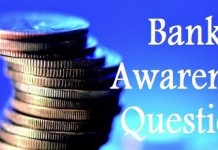Hello Aspirants,
Welcome to Banking Awareness Quiz in AffairsCloud.com. Here we are creating quiz covering important questions which are common for all the bank exams and other competitive exams.
- Which of the following is the most liquid money?
A. M1
B. M2
C. Securities
D. M3
E. Call MoneyA. M1
Explanation:
The most liquid portions of the money supply are measured by M1 because it contains currency and assets that can be converted to cash quickly. “Near money” and “near, near money,” which fall under M2 and M3, cannot be converted to currency as quickly. - Which of the following can issue commercial paper for raising short term funds?
A. Corporates
B. Primary Dealers
C. All-India Financial Institutions
D. Both (B) and (C)
E. All of the AboveE. All of the Above
Explanation:
A Commercial Paper (CP) is an unsecured money market instrument issued as a promissory note. It is a short-term funding tool that highly rated companies, primary dealers (PDs), and all-India financial institutions (AIFIs) can use, typically to meet short-term funding and working capital requirements. - Alterations, if any, on cheques are required to be authenticated by the signature of _______
A. Payee
B. Depositor
C. Drawer
D. Endorse
E. All of the aboveC. Drawer
Explanation:
Alterations, if any, on cheques are required to be authenticated by the drawer’s signature against each such alteration. - What is the purpose of KYC in banking?
A. It is used for customer identification
B. It is used for increasing the CRR of banks
C. It is used against money laundering
D. It is used by the central bank to control liquidity
E. Both (A) and (C)E. Both (A) and (C)
Explanation:
Know your customer (KYC) is the process of a business verifying the identity of its clients. Know your customer policies are becoming much more important globally to prevent identity theft, financial fraud, money laundering and terrorist financing. - Which of the following types of cards is free from credit risk?
A. Credit card
B. Debit Card
C. Prepaid Cards
D. Charge Cards
E. Both (C) and (D)B. Debit Card
Explanation:
A debit card a safe, convenient, risk-free alternative to cash and has no credit risks attached. - Which of the following types of economy is an example of sustainable economy?
A. Capitalist Economy
B. Mixed Economy
C. Socialist Economy
D. Traditional Economy
E. None of the AboveD. Traditional Economy
Explanation:
Traditional economies are considered sustainable because they are less harmful to the environment. - In the field of banking, what does ADF stand for?
A. Additional Dearness Allowance
B. Automated Data Flow
C. Additional Deposit Allowance
D. Automated Deposit Allowance
E. None of the AboveB. Automated Data Flow
Explanation:
The Automated Data Flow (ADF) is a unique initiation by RBI aimed at the purpose of meeting the needs for accurate and consistent flow of data. Automated Data Flow ensures that the data submitted from the banks to Reserve Bank of India is correct and consistent without any kind of manual intervention. - Section 80E of the Income Tax Act provides for deduction of interest paid on Education or study loan taken for higher education. Deduction under section 80E is available for _____
A. 2 years
B. 4 years
C. 8 years
E. 10 yearsC. 8 years
Explanation:
An education loan can not only fund your higher studies but also help save tax. The interest paid on the education loan can be claimed as deduction, as per Section 80E of the Income Tax Act, 1961.The deduction on education can be claimed only when you start the repayment and is available up to eight years, or until the payment of interest in full, whichever is earlier. - A financial contract that derives its value from another asset or an index of asset values is known as __________
A. Insurance Policy
B. Security
C. Derivative
D. Share
E. None of the aboveC. Derivative
Explanation:
In finance, a derivative is a contract that derives its value from the performance of an underlying entity. - Inflation refers to a fall in the value of money. Which of the following is the key measure of inflation in India?
A. Consumer Price Index
B. Wholesale Price Index
C. Personal Consumption Expenditures Price Index
D. GDP Deflator
E. All of the aboveB. Wholesale Price Index
Explanation:
Inflation rates in India are usually quoted as changes in the Wholesale Price Index, for all commodities. Many developing countries use changes in the Consumer Price Index (CPI) as their central measure of inflation.
AffairsCloud Recommends Oliveboard Mock Test
AffairsCloud Ebook - Support Us to Grow
Govt Jobs by Category
Bank Jobs Notification


